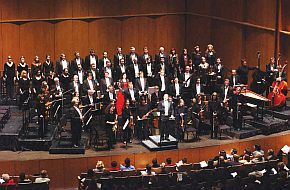
One of the first things I noticed about the performance was an apparently incidental detail: The group opted to use a 16' violone throughout almost all the arias and recitatives, contrary to the more typical practice of using cello alone. This registration decision lent the overall orchestral color a deep, rich hue that suited the overall mood of the group’s interpretation. The ABS performance was not an attempt to make the St. John flashy. This was not one of those performances that strives only to showcase the terrifying (and controversial) turba (crowd) choruses that open Part II. Instead, ABS offered a Passion that was moving, thoughtful, and deeply profound.
This is not to say that the evening lacked virtuosity. A couple of the orchestral musicians were switch-hitters, following the Baroque practice of playing more than one instrument over the course of the evening. John Abberger switched between oboe, oboe d’amore, and oboe da caccia, contributing a stunning effect with the latter instrument in the soprano aria Zerfliesse, mein Herze. Continuo member Steve Lehning laid down his 16' violone and retrieved his gamba for the most poignantly beautiful moment of the entire Passion, Es ist vollbracht. The switch — in function (from continuo player to soloist) as well as in tessitura (from very low to very high in range) — could only have added to the difficulty inherent in this famous piece. Yet Lehning accomplished it with finesse.
The choir was certainly in good form, too. Those turba choruses, with their densely wrought contrapuntal interplay, were sizzling with understated excitement. But that clearly was not where Music Director Jeffrey Thomas had showered all his rehearsal time, nor had he let these difficult choruses overwhelm his interpretive possibilities. There were strikingly beautiful moments in the chorales, those movements that often suffer from a sort of workaday presentation. The final text couplet of In meines Herzens Grunde, for instance, changes the chorale’s subject matter from inward reflection to meditation on the death of Jesus. Thomas guided the chorus to a hushed piano for that final couplet, in clear expressive response to the change of sentiment. I’m describing perhaps 35 seconds’ worth of music, yet the effect haunted me long after the concert ended. It was this attention to the details of music and text intended for a devoutly religious an original audience that made the overall effect so profound. For a couple of hours, if only we allowed ourselves, we listeners were all able to share in the deeply felt aesthetic appreciation of faith that perhaps better characterized 18th-century pietists in Leipzig than most 21st-century Californians.
The soloists also seemed to adopt a somewhat austere position. Alto Judith Malafronte’s Es ist vollbracht was one of the highlights of the performance, though some roughness of tone in earlier numbers hinted that she may not have been in the best voice on this particular evening. Ellen Hargis brought smiles with a cheerful Ich folge dir gleichfalls, and sent chills down my spine with her austere interjections of choral lines into the bass aria Himmel reisse, carried off with great fervor by baritone soloist Joshua Copeland and cellist Shirley Hunt. And William Sharp was hauntingly effective as a detached, resigned, and tired Jesus.
Star of Wonder
Still, the star singer of the evening was young tenor Aaron Sheehan. The role of the Evangelist is a massively demanding one, and Sheehan maintained throughout a stern yet expressive pastoral presence that befitted the austere mood of the evening. I also very much appreciated the fact that I could set down the program booklet and nevertheless understand every word that he sang — no mean feat, considering the volume of words entrusted to that most important narrator.A few bumps in the road can’t go unmentioned. The tempos in the first half of the program were often too fast — not so much for the performers, but rather for the audience, which needs time to process all those dense contrapuntal lines. Himmel reisse, as expertly and excitingly rendered as it was, suffered from such overly eager presentation. So did a number of choruses early in the second half, like the fiery Waere dieser nicht ein Ueberaeter; this little two-line chorus contains lots of syllables, and at times it was a bit difficult to work out what was being said.
The program booklet offered a valuable resource in Lehning’s new English translation of the texts. For the most part, these were sensitively done, leaning generally to the side of literal translation. In the few places where they did take poetic license, I must admit that I sometimes cringed. (One turn of phrase, “How thou,” could have been followed better by “brown cow” than “Lord Christ.” And there were two different translations of the word Knechtschaft in close proximity, for reasons I couldn’t discern.)
Whoever was responsible for the page layout of the booklet deserves some lashes with Pilate’s whip: There was a page turn just as Jesus uttered the most powerful words of the entire passion, “Es ist vollbracht” (It is finished). At the moment when we should have been awed in hushed silence at the stark beauty of that declamation in plain recitative, we were treated to the clunky page turning of 150 audience members. The paper crinkling went on into the opening of the most famous aria of the whole piece, which really seemed a nearly unforgivable — and easily avoidable — transgression.
Despite these small qualms, ABS presented a polished, mature rendering of this great work. Singers and players dug deep beneath the surface to explore Bach’s great essay on the sublime. A most agreeable horror, indeed.

